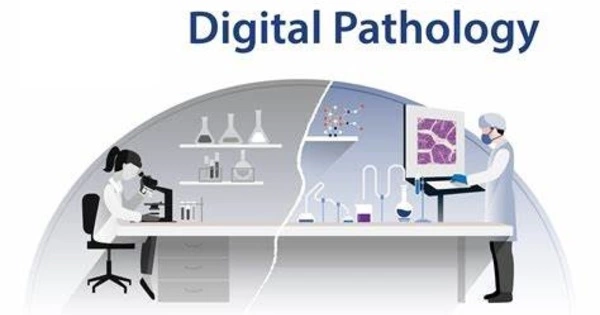Digital pathology is a branch of pathology that deals with the acquisition, management, and interpretation of pathology data in a digital setting. It focuses on data management using data generated from digitized specimen slides. Pathologists in traditional pathology examine glass slides under a microscope to make diagnoses. This process is digitized in digital pathology, allowing for the creation, management, and interpretation of digital images of pathology slides. Digital pathology employs virtual microscopy through the use of computer-based technology.
Glass slides are digitalized and can be viewed, managed, shared, and analyzed on a computer monitor. Because of the success of machine learning and artificial intelligence in healthcare, the field of digital pathology is growing and has applications in diagnostic medicine, with the goal of achieving efficient and cheaper diagnoses, prognosis, and prediction of diseases through the practice of Whole-Slide Imaging (WSI), which is another name for virtual microscopy.
Key components and aspects of digital pathology include:
- Whole Slide Imaging (WSI): Whole slide imaging is the process of scanning entire pathology slides in order to generate high-resolution digital images. Pathologists can then zoom in, pan, and navigate through the entire specimen by viewing these digital slides on computer screens.
- Image Analysis and Processing: Image analysis tools and software are frequently used. Pathologists can use these tools to help them quantify various features, identify patterns, and even provide automated pre-screening for certain conditions.
- Storage and Management: Because of the high resolution of digital images, it generates a large amount of data. Effective storage, management, and retrieval systems are required to efficiently handle this data.
- Telepathology: Digital pathology enables remote access to pathology images, allowing pathologists to collaborate, consult, or provide diagnoses from different locations. This is particularly valuable for areas with limited access to expert pathology services.
- Integration with Electronic Health Records (EHR): It is compatible with electronic health record systems, allowing pathology data to be seamlessly integrated into a patient’s overall medical record.
Digital pathology has the potential to streamline pathology workflows by reducing slide transportation time and allowing for more efficient case management.
While digital pathology has many benefits, including improved accessibility and collaboration, it also has some drawbacks, including the need for standardized practices, data security concerns, and the initial costs associated with implementing digital pathology systems. Digital pathology is expected to play an increasingly important role in modern healthcare as technology advances.
















